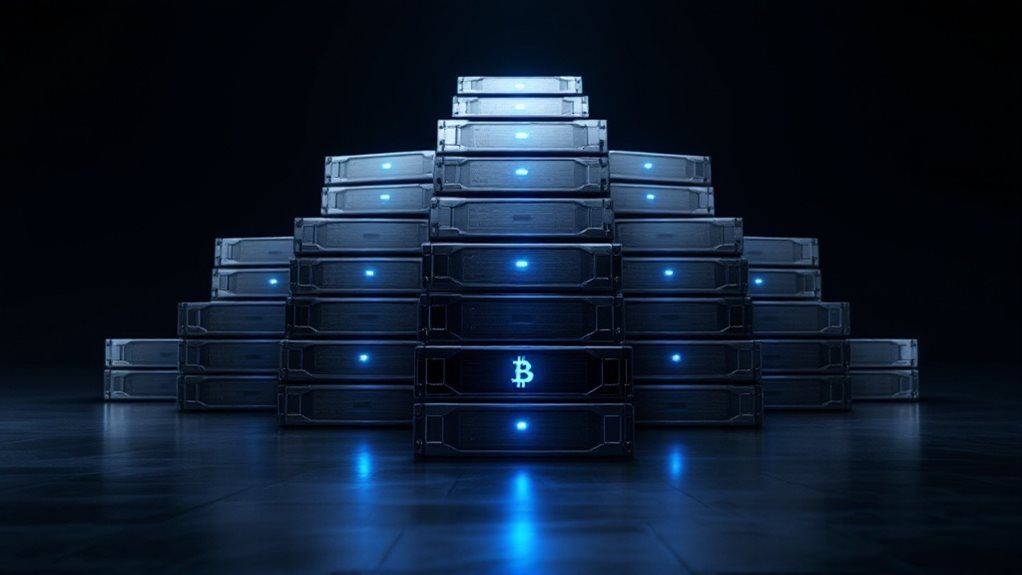Bitcoin’s blockchain reached about 445.49 GB by the end of 2022 and continues to grow steadily. It expands by roughly 1 MB every hour, or about 1 GB every few days. With an annual growth rate of 36% since 2016, experts expect it to reach nearly 5,450 GB by 2024. The increasing size affects how people can participate in the network, raising important questions about Bitcoin’s future development and accessibility.
Quick Overview
- Bitcoin’s blockchain reached approximately 445.49 GB by the end of 2022 and is projected to grow to 5,450 GB by 2024.
- The blockchain grows steadily at about 1 MB per hour, adding roughly 1 GB every few days.
- Full nodes require at least 1TB of SSD storage space, with 2TB recommended for future growth accommodation.
- The blockchain’s size has maintained a consistent annual growth rate of 36% since 2016.
- Current average block size is 1.805 MB, with a theoretical maximum of 4 MB following the 2017 network upgrade.

How big is Bitcoin’s blockchain, and why does its size matter? The Bitcoin blockchain has grown tremendously since its creation, reaching approximately 445.49 GB by the end of 2022. It’s expected to reach nearly 5,450 gigabytes in 2024, growing by about one gigabyte every few days. This rapid growth shows just how much the network has expanded over time.
The blockchain’s size increases at a steady pace of around 1 MB per hour. Since 2016, it’s been growing at an annual rate of 36%, expanding from 95 GB to 435 GB by October 2022. Current data shows blocks averaging 1.805 MB in size. At this rate, experts predict it’ll easily surpass 1 TB by 2030. The blockchain’s growth is limited by its block size, which can’t exceed 1 MB, though a 2017 upgrade allows for a theoretical maximum of 4 MB.
For those running full nodes on the Bitcoin network, storage requirements are substantial. Currently, participants need at least a 1TB SSD or NVMe disk space, though 2TB is recommended to account for future growth. While a terabyte hard drive would cover current growth for many years, not everyone needs to download the entire blockchain to participate in the network. The system relies on Proof of Work consensus to maintain the integrity of these stored transactions. This decentralized system allows for peer-to-peer transactions without the need for intermediaries or central authorities.
The size of Bitcoin’s blockchain presents both technical and practical challenges. The network can only process up to 7 transactions per second, which creates a bottleneck in transaction processing. The Lightning Network helps address this scalability issue by processing multiple transactions off-chain. This limitation has sparked ongoing debates about whether to increase the block size to improve scalability.
The blockchain’s growing size also affects how decentralized the network can remain. As the storage requirements increase, fewer people may be able to run full nodes, which could impact the network’s security and accessibility. Between 2019 and 2021, the blockchain grew from 150 GB to 250 GB, demonstrating the rapid pace at which storage needs are expanding.
For peak performance, users running full nodes are encouraged to use SSD or NVMe drives rather than traditional hard drives, as these provide faster synchronization with the network. This storage requirement represents one of the key technical challenges facing Bitcoin’s future development, as the network tries to balance accessibility with security and decentralization.
The blockchain’s size reflects Bitcoin’s growth and adoption over the years, but it also highlights the ongoing challenges of maintaining a decentralized digital currency system that needs to store every transaction ever made on its network.
Frequently Asked Questions
How Many Copies of Bitcoin’s Blockchain Exist Worldwide?
There’s no exact count of Bitcoin blockchain copies, but it’s likely between 50,000 to 100,000 worldwide.
That’s because each full node maintains a complete copy of the blockchain. While there are about 21,000 publicly visible nodes, experts believe there are many more private nodes that aren’t counted.
The blockchain is stored across these nodes in different countries, with the US and Germany having the most visible ones.
Can I Delete Old Blockchain Data to Save Storage Space?
Yes, Bitcoin users can delete old blockchain data through a process called “pruning.”
It’s like clearing out old files to make more space. Pruning can reduce storage needs by up to 90% while keeping the most important data.
A pruned node only needs about 2 GB of space instead of the full 5450 GB.
However, pruned nodes can’t share the complete blockchain history with other users or check very old transactions.
What Happens if My Device Runs Out of Storage Space?
When a device runs out of storage space while running a Bitcoin node, it can’t process or store new blocks. The node won’t sync with the network anymore, and it’ll stop working properly.
Users have options though – they can free up space, use pruning to keep only recent data, or switch to a light client that needs less storage.
Some people also use external drives or cloud storage as alternatives.
How Much Energy Does Storing the Bitcoin Blockchain Consume?
The exact energy used to store Bitcoin’s blockchain isn’t well documented, but it’s much smaller than Bitcoin mining’s energy use.
While mining consumes about 150 terawatt-hours annually (similar to a small country), storage needs are relatively modest.
Modern SSDs, which many people use to store the blockchain, are quite energy-efficient.
As the blockchain grows by about 1 GB every few days, storage energy needs gradually increase too.
Does Running a Bitcoin Node Require Specialized Hardware for Storage?
Running a Bitcoin node doesn’t require specialized storage hardware. A regular computer with a solid-state drive (SSD) and enough space works fine.
The blockchain needs about 500 GB of storage for a full node, but there are options that use less space. While high-end SSDs can make things run faster, any decent modern hard drive will do the job.
Many people even run nodes on basic hardware like Raspberry Pi computers.





